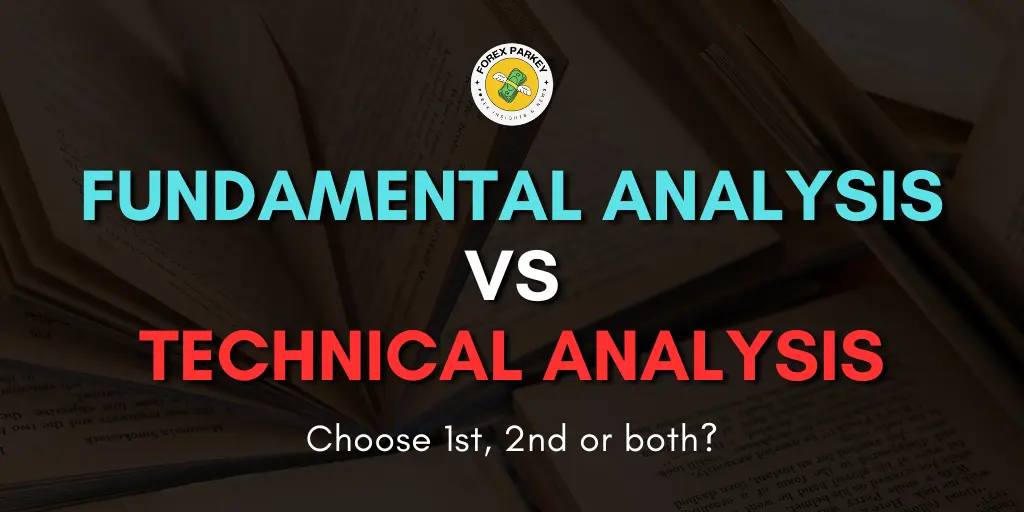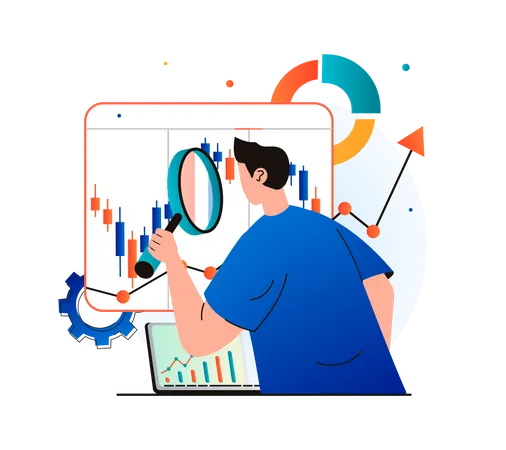When it comes to analyzing the forex market, there's always a debate between the fundamentalists and technicians!
The fundamentalists look at economic factors like interest rates and GDP growth to figure out which currencies offer good value. They're all about buying undervalued currencies and selling the overvalued ones.
The techies, on the other hand, don't care much about economic data. They use historical price charts and indicators to identify patterns and trends. Things like moving averages, Fibonacci retracements, pivot points, you name it! For them, price behavior reveals all.
I say, why choose? Fundamental analysis tells you which direction a currency should go long-term, while technical analysis allows you to time entries and exits along the way. Together they make a powerful combination in the forex game!
Well, let's take a deeper dive over both of these aspects of forex trading and analysis!
Fundamental Analysis Vs Technical Analysis

When analyzing the forex market, traders rely on two main approaches – fundamental analysis examines economic factors while technical analysis studies historical price charts and trends. Both offer valuable insights.
The key introductory points are:
Fundamental Analysis

Fundamental analysis examines a company's financial health, management quality, competitive position, and industry trends to determine the intrinsic value of its stock. Analysts study financial statements, earnings reports, economic indicators, and other qualitative and quantitative factors. The goal is to estimate future performance and compare the stock's intrinsic value to its current market price.
Fundamentals help identify undervalued stocks with strong growth potential as well as overpriced stocks. However, the subjective interpretation of qualitative factors makes standardizing analysis difficult. Fundamental signals also focus on past data. Combining insights from technical indicators paints a more complete picture.
Tools of Fundamental Analysis

Fundamental analysis relies on various tools and data sources to assess the factors that influence currency values. Here are some of the key tools:
Economic Indicators
Economic indicators like GDP, unemployment, inflation, trade balances, and interest rates provide critical insights into a country's economic health. Analysts closely track indicator releases in major economies like the US, Eurozone, China, and Japan that impact currency markets. For example, higher-than-expected GDP growth may lead to currency appreciation.
Central Bank Policies
Central banks directly impact interest rates and money supply, which are major drivers of growth and currency prices. Statements and policy decisions by the Federal Reserve, ECB, PBoC, and BoJ offer clues into future rate moves. Dovish stances tend to weaken currencies while hawkish policies lead to appreciation.
Forex Calendars
Calendars like DailyFX and Forex Factory track high-impact economic events and data releases. They help traders prepare for volatility around news events that cause sharp currency fluctuations. Scheduling positions before announcements allows capitalizing on price swings.
Geo-political Developments
Political stability, sovereign credit ratings, regulations, and election outcomes influence investor confidence and capital flows between countries. Fundamental analysts stay updated on policy changes and political risks that may impact currency markets.
Sentiment Indicators
Gauges like consumer confidence, manufacturing PMI, and business optimism surveys provide leading signals on economic trajectory. Declining sentiment warns of downturns and currency depreciation ahead of actual data releases.
Combining insights from various fundamental indicators, news, central bank policies, and economic data allows for determining currency mispricings and trading opportunities. It can be said that no single tool provides the full picture.
Pros and Cons of Fundamental Analysis
Pros
Cons
Technical Analysis

Technical analysis involves studying historical price charts, trends, and market statistics to identify trading opportunities. The key premise is that history tends to repeat itself – technical analysts believe they can predict future price movements by spotting similar historical patterns. Traders rely on indicators like moving averages, oscillators, and Fibonacci levels to generate trade signals and plan entries and exits.
Chart pattern analysis is also widely used to spot trend continuations or reversals – formations like head and shoulders, triangles, and flags provide clues. Technical analysis works well for short-term traders aiming to time the markets. However, no single indicator provides perfectly accurate signals – combining analysis methods paints a clearer picture.
Markets discount everything, the how is more important than why, price moves in trends, and history tends to repeat itself.
Tools of Technical Analysis

Technical analysts rely on various indicators and chart patterns to analyze market conditions and identify trading opportunities. Here are some key tools:
Volume Analysis
Volume indicates the total number of shares or contracts traded for a security over a period of time. Higher than average volume confirms the strength and validity of trends, chart patterns, and breakouts. Volume typically precedes price – rising volume points to an emerging uptrend, while falling volume suggests waning momentum. Analyzing volume surges on breakouts signals sustainable new trends.
Trendlines and Channels
Trendlines connect swing highs and lows to show the slope and direction of trends. Channels further depict support and resistance zones for planning entries and exits. Breakouts beyond trendlines signal potential trading opportunities. Drawing valid trendlines requires at least 2 touchpoints with price, but more contact points increase reliability.
Chart Patterns
Formations like head & shoulders, triangles, flags, and rectangles provide clues on the continuation or reversal of trends. Common patterns are reliable across timeframes and asset classes. Volume confirmation distinguishes reliable signals from false breakouts. No single pattern works perfectly in isolation – combining analysis with indicators and volume paints a clearer picture.
Fibonacci Ratios
Key Fibonacci retracements and extensions identify likely reversal zones that act as support and resistance areas. Ratios like 0.618, 1.618, and 2.618 are used to plan profit targets and stop losses. Fib levels are most reliable on higher timeframe charts using swing highs and lows rather than minor reversals.
Candlestick Patterns
Candlestick charts reveal the battle between buyers and sellers. Reversal and continuation patterns precede impending volatility and trend reversals. However, candlestick signals require next-period confirmation to avoid false signals. Combining candlestick patterns with other indicators provides reliable trade setups.
Momentum Oscillators
Oscillators like RSI, Stochastics, and MACD gauge overbought or oversold conditions and divergence from price action. Crossovers of signal lines or indicator levels generate trade signals. Divergence warns of waning momentum ahead of trend reversals. Oscillators work best in ranging or sideways markets.
Effect of Macroeconomic Indicators on Forex Trading
Macroeconomics holds a significant importance in forex trading. By keeping a keen eye on the macroeconomics of a country, traders/investors can make well-informed investments in the forex market.
Investors and traders analyze various economic indicators such as Gross Domestic Product (GDP), Inflation, Consumer Price Index (CPI), and Unemployment Rate to assess the condition of the economy of a country. For example, if the inflation rate of a country is high it may cause its currency to lose value and the investor/trader divests that currency.
Combining analysis from charts, volumes, and indicators provides high probability and low-risk trade setups. No single tool works perfectly in isolation.
Pros and Cons of Technical Analysis
Pros
Cons
Understanding Fundamental Analysis vs Technical Analysis with the Help of an Analogy

Consider a student trying to gather information about his/her project work. The student has the choice between two options – Books and the Internet.
Say, the student opts for books as a source of collecting information. He may have to go through at least 4-5 books to find ample and suitable information. It is good that the student will get to have a deep dive into different topics, but this method requires a lot of time and energy. Alternatively, the student can make use of popular and in-demand tools such as Artificial Intelligence (AI).
In present day and age, the internet is attracting a large number of users. The former option is Fundamental Analysis in which you analyse different factors and tools like annual reports etc., and the latter describes Technical Analysis.
FAQs related to Fundamental Analysis Vs Technical Analysis
What is Fundamental Analysis in Forex Trading?
Fundamental analysis evaluates economic indicators and events to predict currency value changes.
Does “history repeat itself” in Technical Analysis?
History repeats itself is an understatement because human behaviours are unpredictable different behaviours may have different impacts on the economy of a country. However, coincidences may occur.
What is Technical Analysis in Forex Trading?
Technical analysis uses historical price data and chart patterns to forecast future price movements.
Can beginners use Fundamental Analysis?
Yes, beginners can start with basic economic concepts and gradually learn to interpret data for trading.
What is Gross Domestic Product (GDP), and how does it affect Fundamental Analysis?
Gross Domestic Product (GDP) refers to the monetary value of the final goods and services produced in a country in one year. There is a strong relationship between gross domestic product and fundamental analysis. An increase in Gross Domestic Product (GDP) means a higher currency rate.
Is Technical Analysis only for short-term Trading?
No, technical analysis can be used for both short-term and long-term trading strategies.
Which is easier for beginners, Fundamental Analysis Vs Technical Analysis?
Technical analysis may be more accessible for beginners due to visual chart patterns and indicators.
What are some common Technical Indicators?
Common indicators include Moving Averages, Relative Strength Index (RSI), and Moving Average Convergence Divergence (MACD).
How important is volume in Technical Analysis?
Volume is crucial as it confirms the strength of a trend and the significance of chart patterns.
🔗 End Note

So in the great debate between Fundamental analysis vs Technical analysis, I think both have merit in the forex game. Fundamentals are great for determining long-term currency valuation and spotting big macro trends.
But technicals help time shorter-term entries and exits. Relying on fundamentals alone leaves money on the table!
💭 My advice is don’t limit yourself. Use both tools to get the full picture!
Check the economic calendar for data releases, keep an eye on central bank policies, but also watch key support/resistance levels on the price charts. Marry fundamental insights with technical signals. This one-two combo gives you an edge to profit from short and long-term currency swings.






